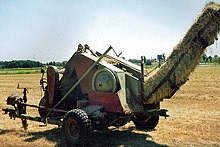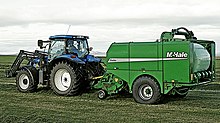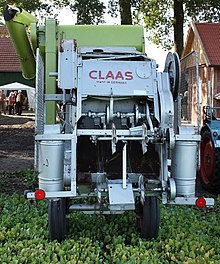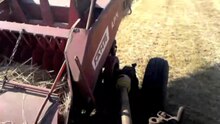Baler (agriculture)

The baler is used to press hay , straw or grass silage that is produced in agriculture into bales . So it can be stored to save space. Balers are pulled by a tractor and driven by the PTO shaft.
Today, round or square bales (weight up to 400 kg / piece for hay, up to 1000 kg / piece for silage) are usually pressed. Large square bales can only be moved with the front loader of a tractor or the telehandler , while round bales can also be rolled over short distances. There is a bale collection trolley for loading square or round bales .
The bales can either be tied with nets or twine, with the latter being differentiated between “edge to edge” and “cover edge” (beyond the edge). A special press is required for each of these two methods.
Round baler
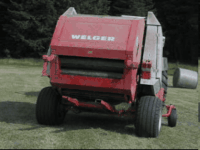
The most popular baler is the round baler. This was introduced in 1972 by the Vermeer Company . Allis-Chalmers presented a forerunner of the round baler in 1947 with the Roto-Baler , the bales of which, however, were significantly smaller.
To produce these cylindrical bales, the hay is simply rolled up in it. This is done using rubber-covered belts (press with variable chamber) or steel rollers (fixed chamber press). Once the bale has reached a certain size, it is tied with twine or netting before the rear part of the press opens and the bale can roll out. The balls have a diameter of 120 to 180 cm and are 120 cm wide. The weight is between 200 kg for loosely pressed straw and 1000 kg for grass silage with a dry matter of only 20%. Silage bales in particular are then welded with the bale wrapper and can therefore also be stored outdoors. Alternatively, there are also baling presses with an integrated bale wrapping device.
While Vermeer has remained the most important manufacturer in the USA, these presses are now sold in Germany by the manufacturers Kuhn , Deutz-Fahr , Case IH , Claas , Krone , Massey Ferguson , New Holland , John Deere , Fendt and Lely .
Square baler
Another baler produces large square bales that are held in place with about six knotted cords.
Large
These bales weigh significantly more than round bales because they are pressed much more tightly. The width of 80 to 120 cm and the height of 50 to 130 cm are determined by the type of press. The length of the bale is adjustable from 50 to 320 cm. The first big baler was introduced in 1978 by the Hesston Corporation .
technology
With the help of a pickup , the material to be pressed is picked up and pushed together with screws a little across the direction of travel. An optionally switchable cutting unit happens. Then the packers follow. These are material slides that are mounted eccentrically on a shaft. They compress the material to be pressed against retaining fingers. As soon as the set pressure is reached, these retaining fingers open the way into the press channel. The press channel runs lengthways through the machine. From the front, the plunger (also known as a hammer) pushes the material supplied from below further back. The plunger moves back about once every second. The jerky load on the drive is alleviated by a flywheel . This wheel, weighing around 300 kg, rotates at an input speed of 1000 rpm directly behind the PTO shaft input. The press channel is narrowed at the rear by prestressed hydraulic cylinders. The knotters are on top of the press. In the rear region sit approximately one meter long twine needles that the baler pierce through the ball and indicate the knotter. The elaborately built knotters are kept clean by blowers from short stalks, which would impair their function. The knotters are divided into Deering knotters and Cormick knotters. About the roles chute leave the bale press. There is a toothed wheel on the roller chute which measures the bale length and thus triggers the knotting process. For road transport, the press channel is relieved by releasing the pressure from the cylinders. There is also an optional bale ejector, which actively transports the last bale to the rear. The chute is then folded up and locked.
Small

High pressure press
The so-called high - pressure bales , which were mainly pressed in the 1960s / 1970s, with their weight of approx. 10 to approx. 30 kg, are particularly interesting for hobby, small and horse farmers without large machinery. These relatively light bales have the advantage that they can be moved by one person and therefore do not require a front loader or major modifications. Because of the good portionability and the flexible storage options (e.g. also in the attic), they are still of economic importance for some farmers, especially due to the demand from horse owners. They are also used as insulation and building material in the straw bale house . These bales are tied with two to four strings and have approximate dimensions of 40 × 50 × 100 cm. Because of the comparatively high cost of handling many small bales, they are no longer used by large farms.
Small square baler ( Welger ) with bale guide
Small bales are formed in the following work steps: The material to be pressed is picked up from the ground by means of a rotating drum with flexible spring tines arranged transversely to the direction of travel, the so-called pick-up, and conveyed into a channel above that is the width of the Pick-up corresponds to the press material picked up. In this channel, a so-called packer (designed as a tine or a screw conveyor) moves and pushes the pressed material into the press channel, in which a piston fitted with a knife moves back and forth in the direction of travel. The counter knife is located in the piston channel, whereby the pressed material is cut to the later bale width. The piston pushes the hay or straw backwards and compresses it into a bale.
In this area there is a “measuring device” designed as a toothed wheel, which triggers the binding mechanism when a certain amount of hay is reached. The ball length and thus the weight can be adjusted using the toothed wheel. When the binding process has been initiated, two rounded needles pierce the material in the press channel. You guide the pressed yarn over the knotter and slide back again. The knotters now carry out the actual binding process. After binding, the pressed yarn is cut by sharp knives on the knotter.
When the next bale is produced, the tied bale is pushed out of the baling channel and falls to the floor behind the baler. In order to avoid the labor-intensive collecting of the small bales lying around the field, a trailer is usually attached directly to the baler. To do this, the bales were initially pushed from the following bales through a guide channel located on the ejection and had to be carefully stacked on the trailer by one or two workers. In order to save manpower, the bales have been increasingly "thrown" onto the trailer by two hydraulically driven, counter-rotating rubber bands, the so-called bale throwers , since around 1980 . The trailer must be equipped with a cage-like attachment to be able to catch the incoming bales.
Optionally, a bale counter controlled by the knotter can be attached. This is especially important when the press work takes place as wage labor.
All movement sequences in a high-pressure press must be precisely timed to match, otherwise the machine can be seriously damaged. Damage can be caused by cracked chains or sheared connecting elements of the gear wheels on the hubs of the various drive components. The typical damage symptoms are z. B. rake tines destroyed by the piston or bent knotter needles.
The automatic baling press for small square bales does not differ much today from the model from 1940. The assemblies, but not their arrangement and size, basically correspond to those of the large balers.
Low pressure press
The low pressure press was first manufactured in the US by New Holland and used a small gasoline engine as a power source. The basis for this was provided by the baler, invented in 1937, with double lacing and automatic crop pick-up. Previous models required the bales to be tied manually. Earlier versions of these models were permanently installed and were driven by a V- belt. The hay had to be brought to the press and filled in manually. The only significant change since 1940 was the replacement of the internal combustion engine with the power take-off of the pulling tractor .
Web links
Individual evidence
- ↑ History ( Memento from September 24, 2009 in the Internet Archive )
- ^ Charles H. Wendel, Andrew Morland: Allis-Chalmers Tractors . Motorbooks International, 1992, ISBN 978-0-87938-628-3 ( limited preview in Google Book Search).
- ↑ Welcome to the Hesston® Heritage Club ( Memento from December 9, 2012 in the Internet Archive )
- ↑ Das Erste: Video "Sachgeschichte - Strohballenknoter" - The broadcast with the mouse. October 3, 2012, accessed September 6, 2019 .
- ↑ Small Square Balers. newholland.com, archived from the original on November 13, 2006 ; Retrieved September 10, 2012 .



